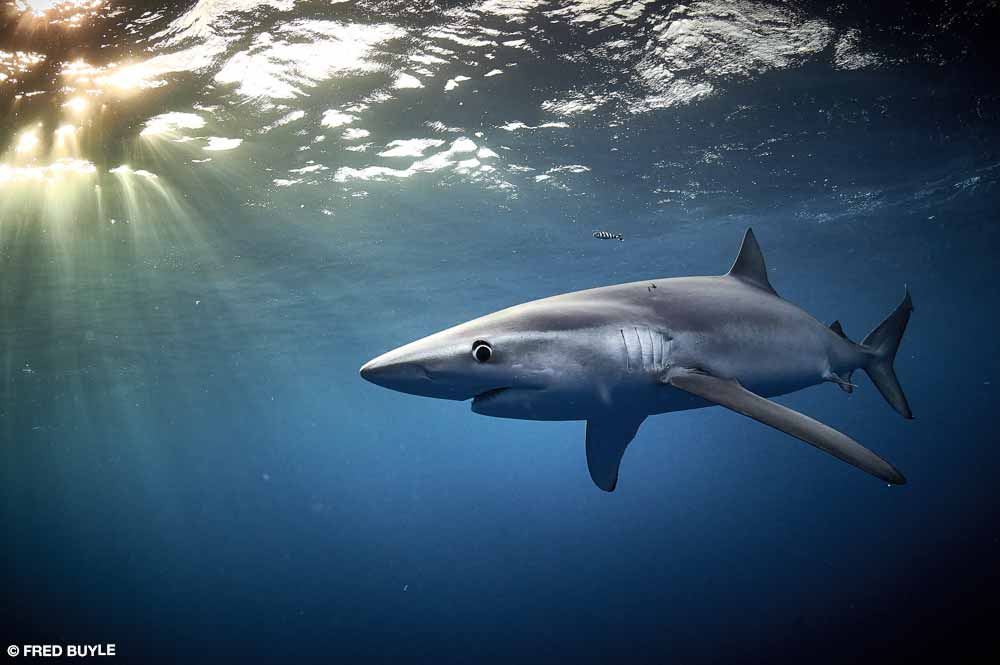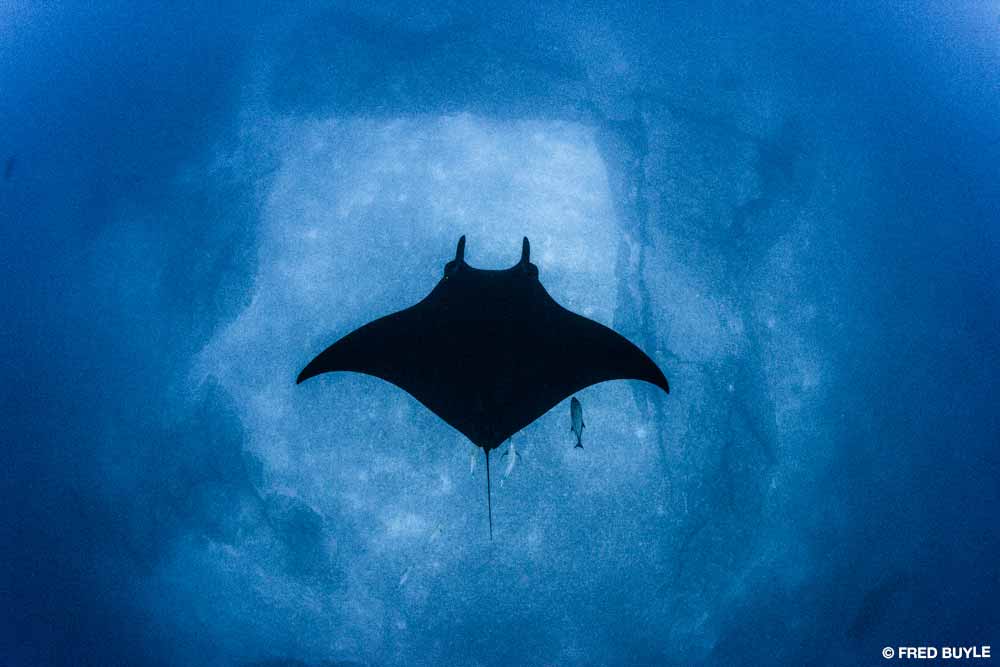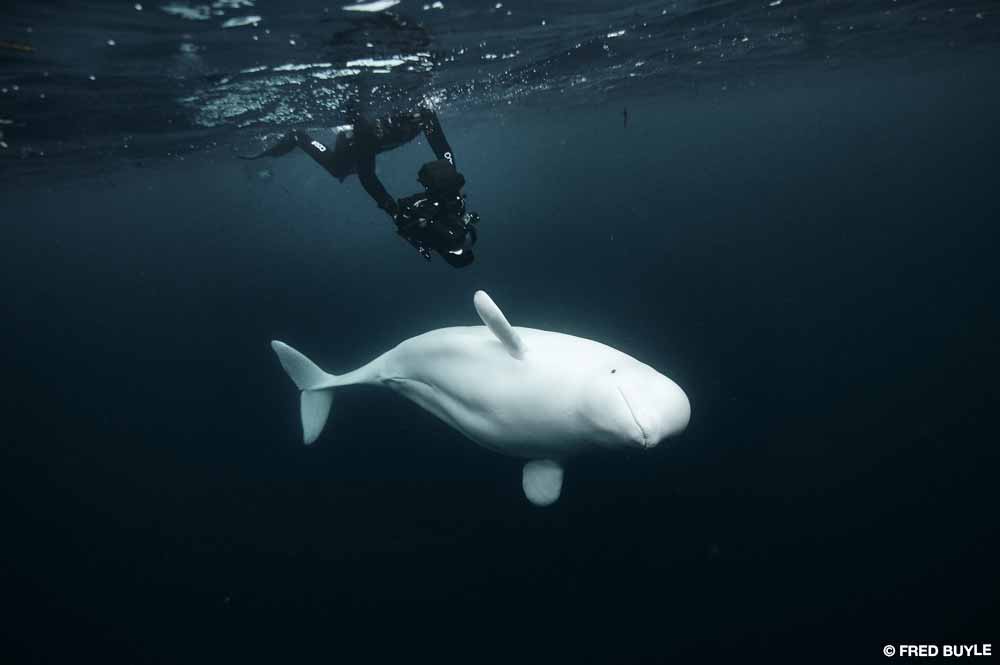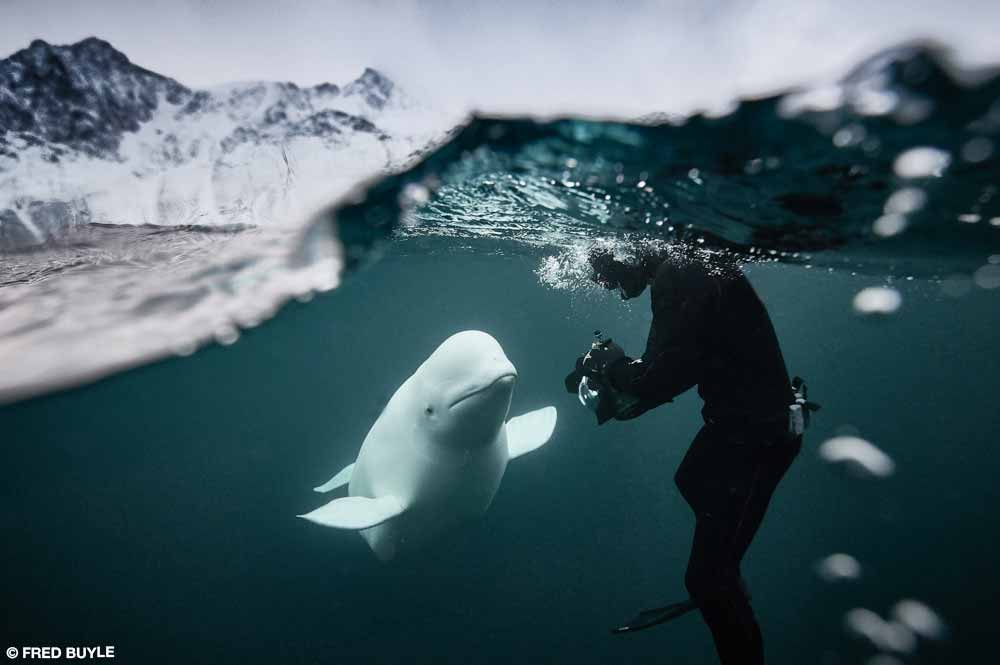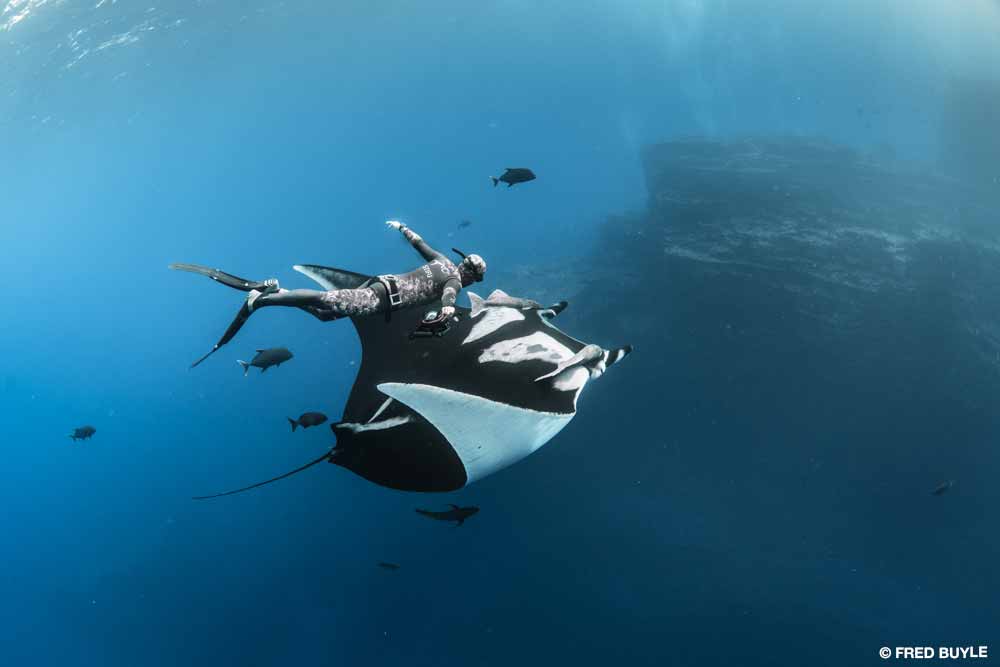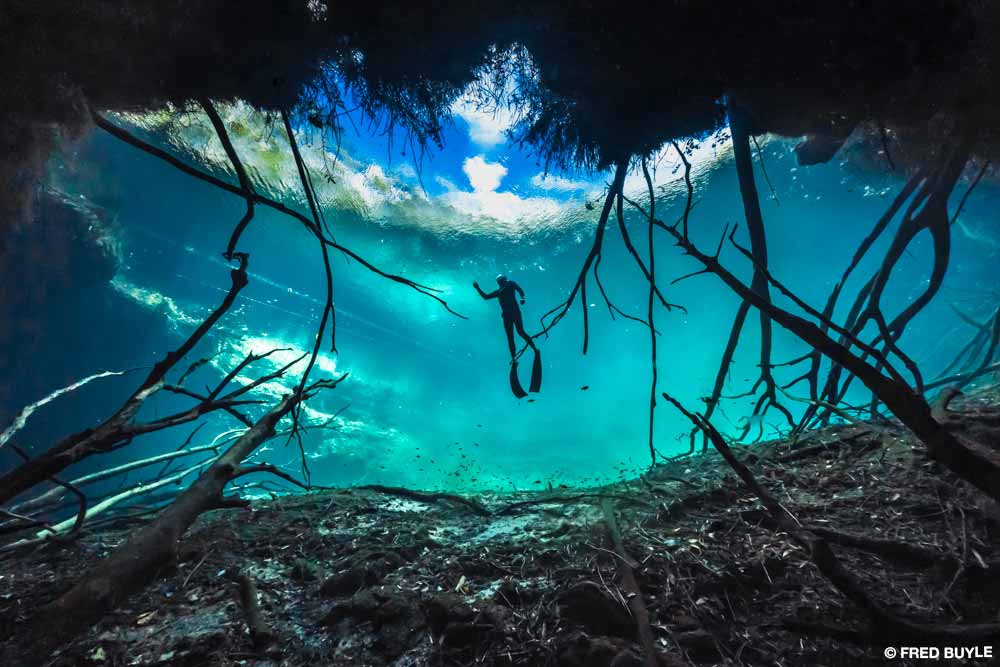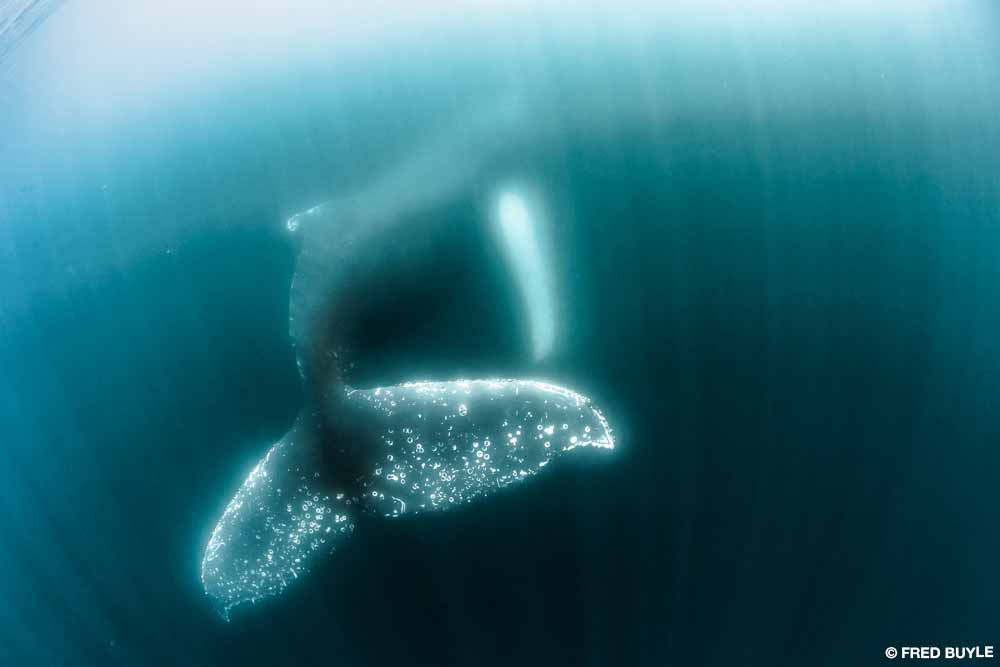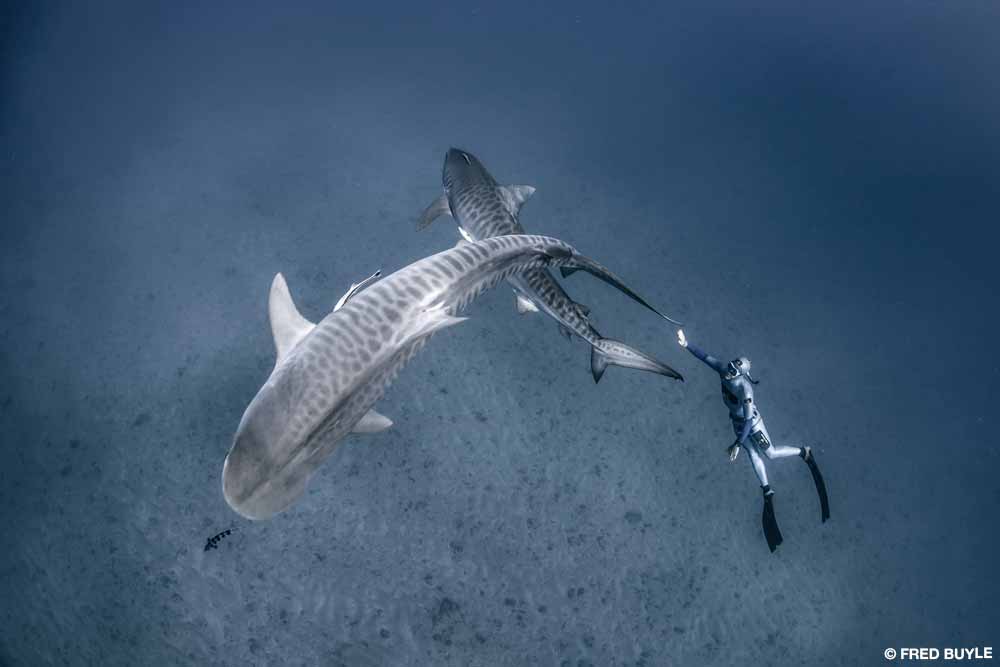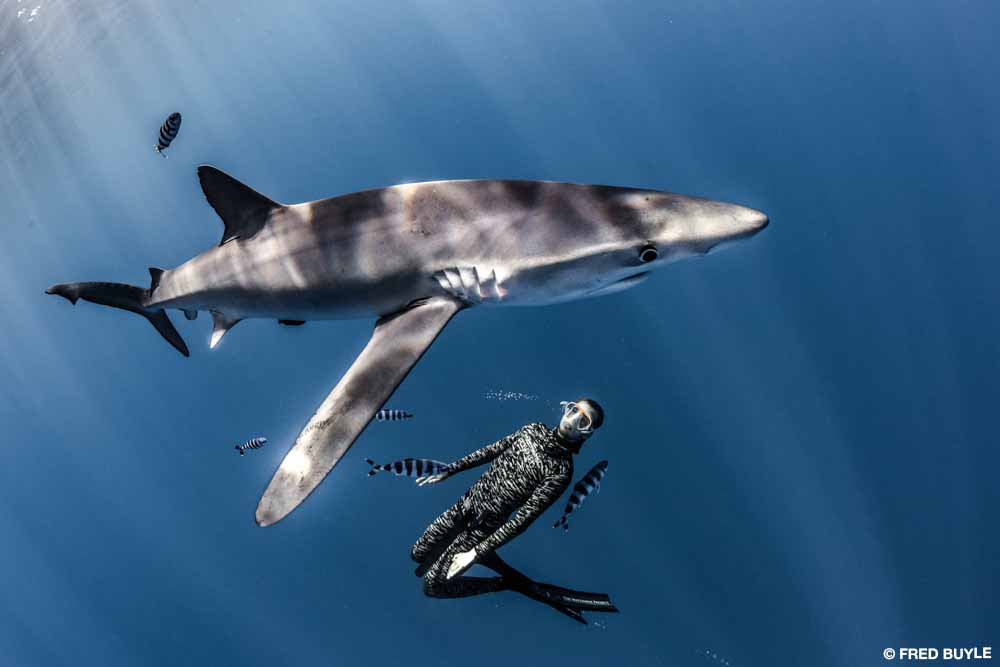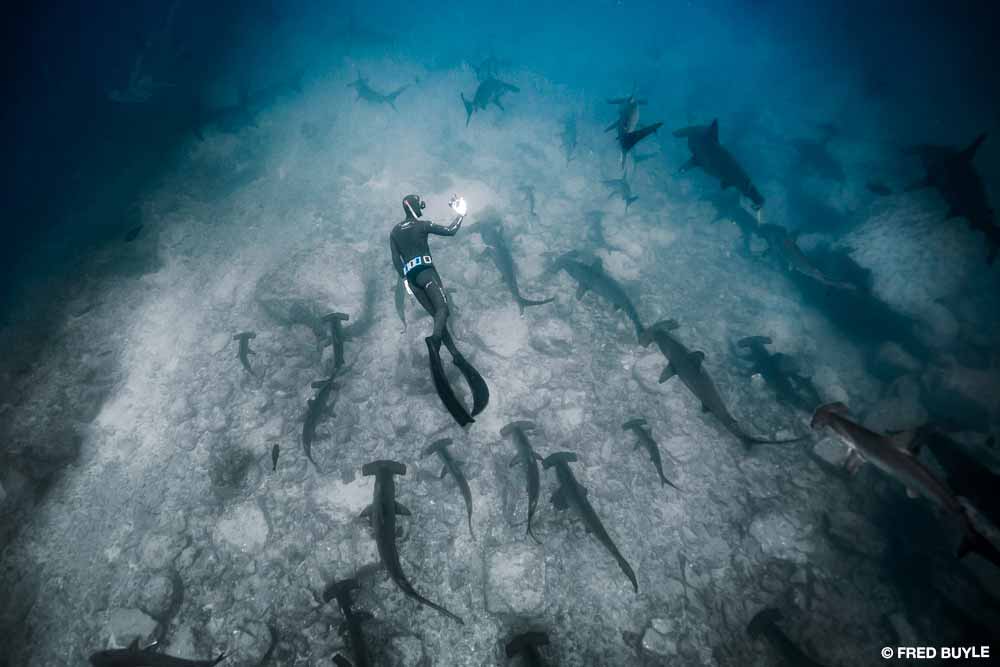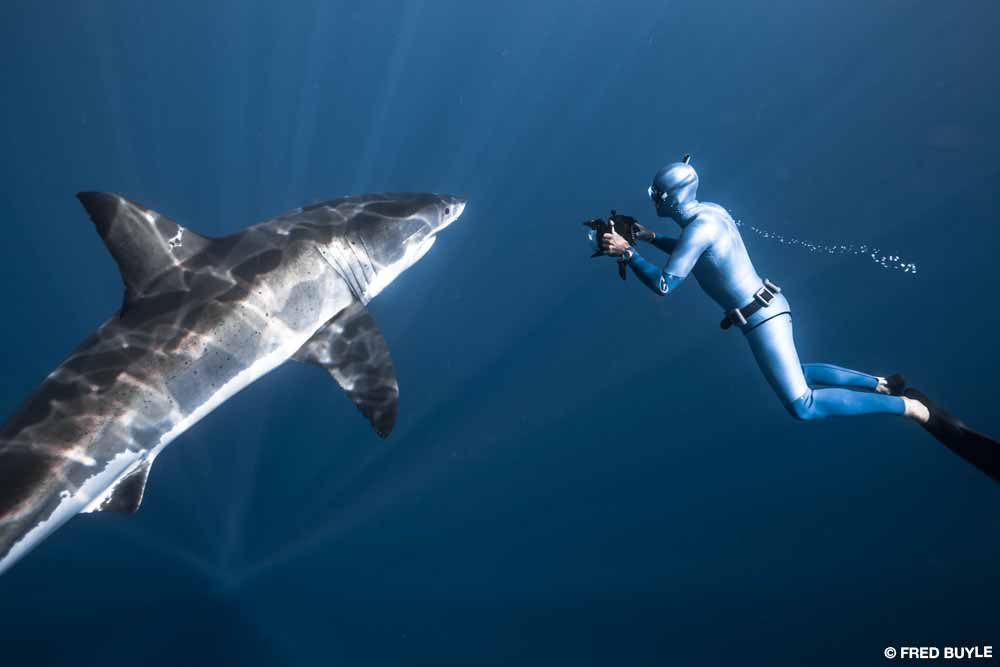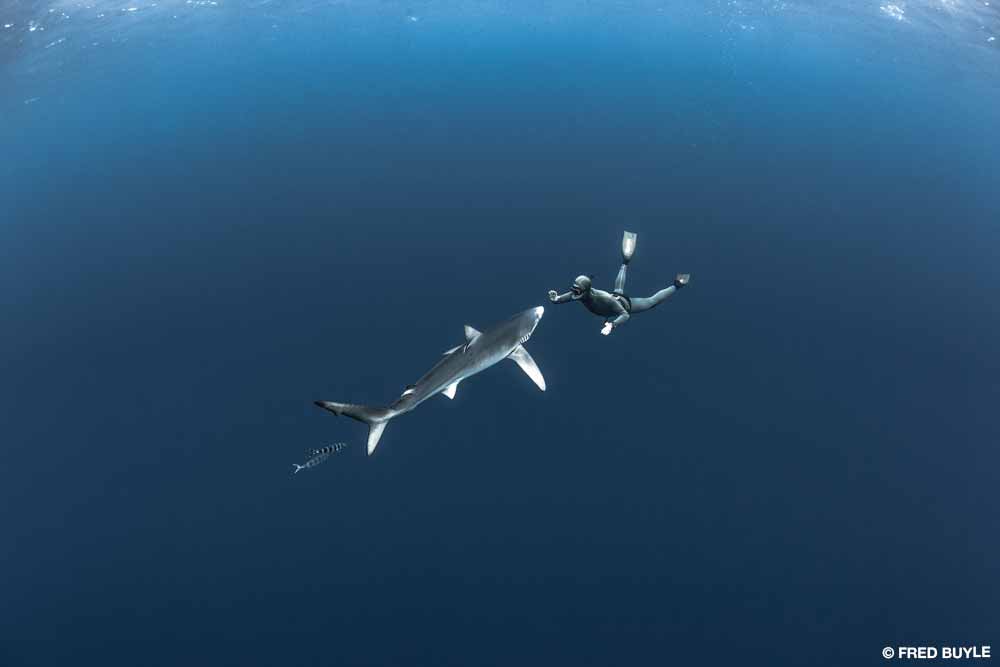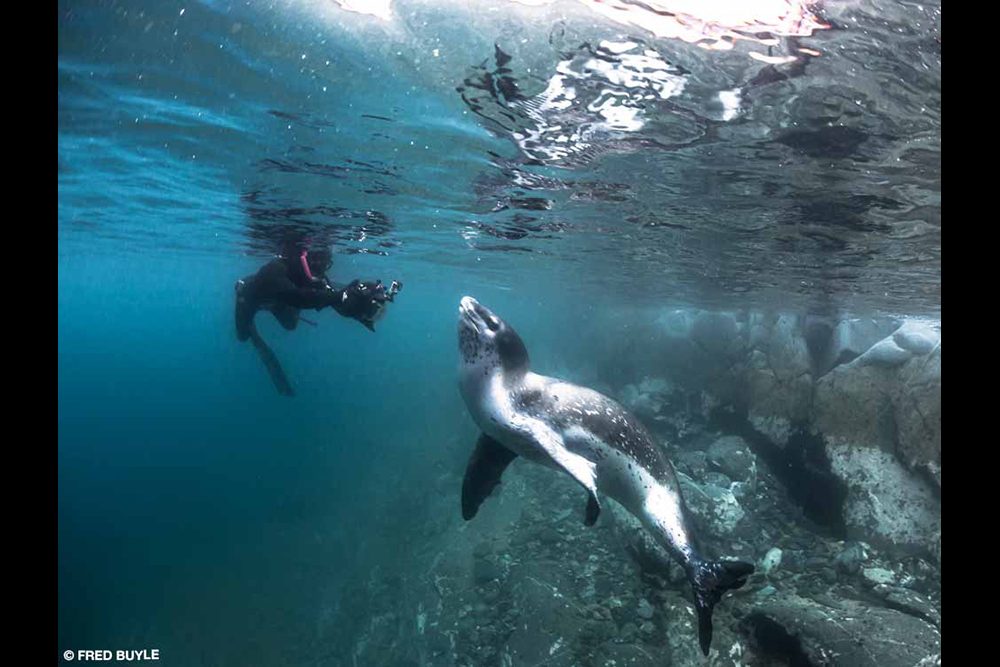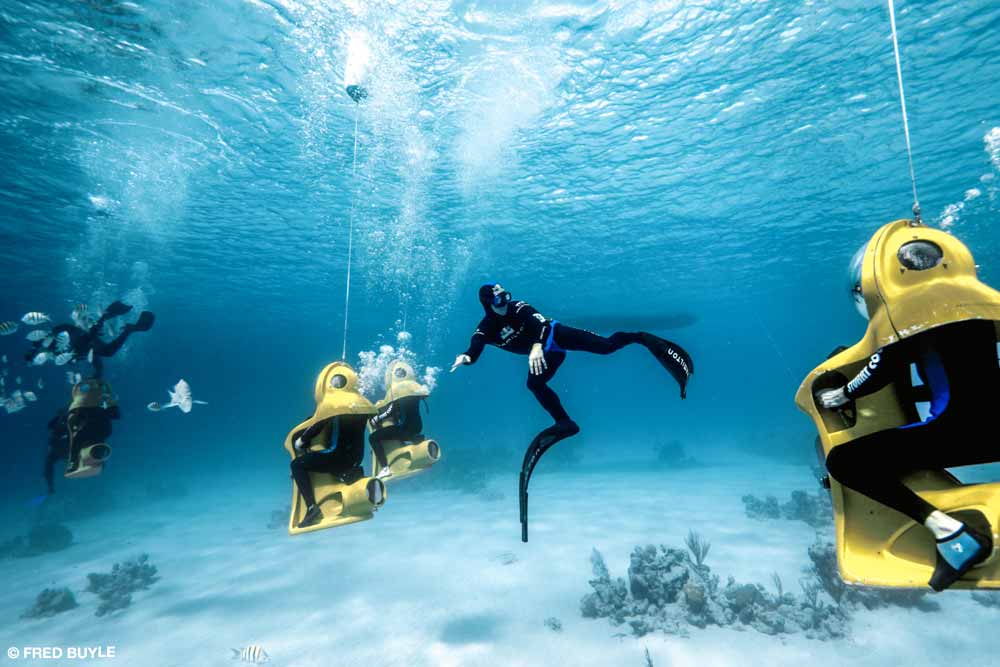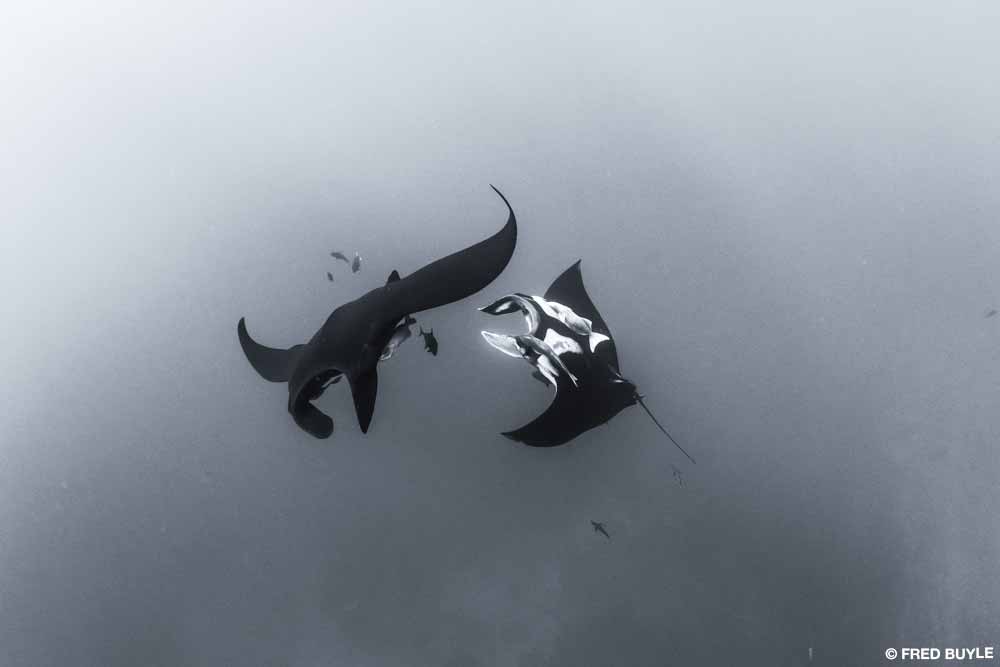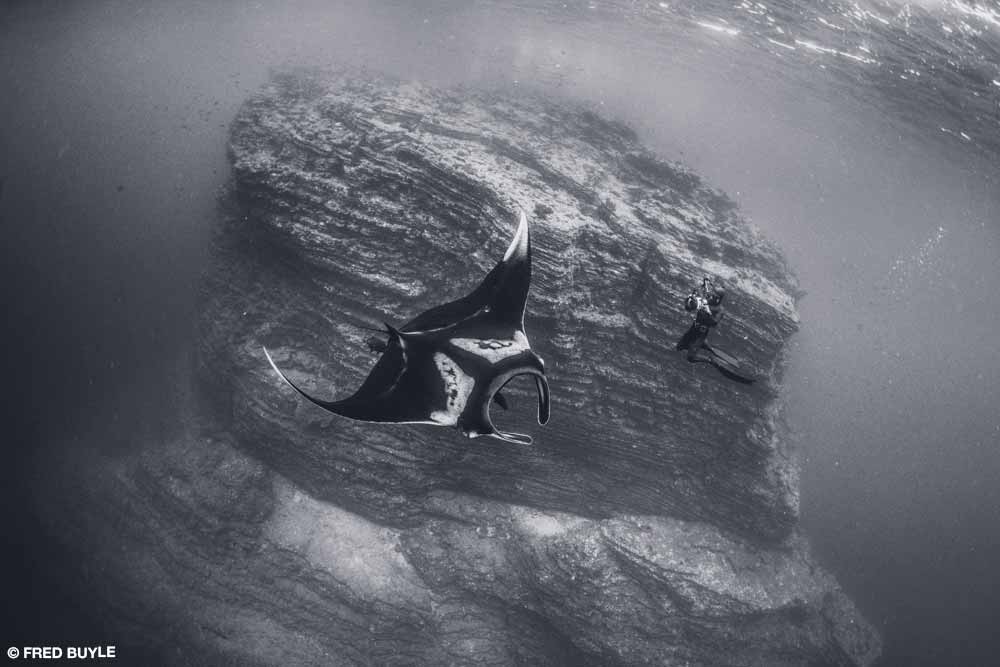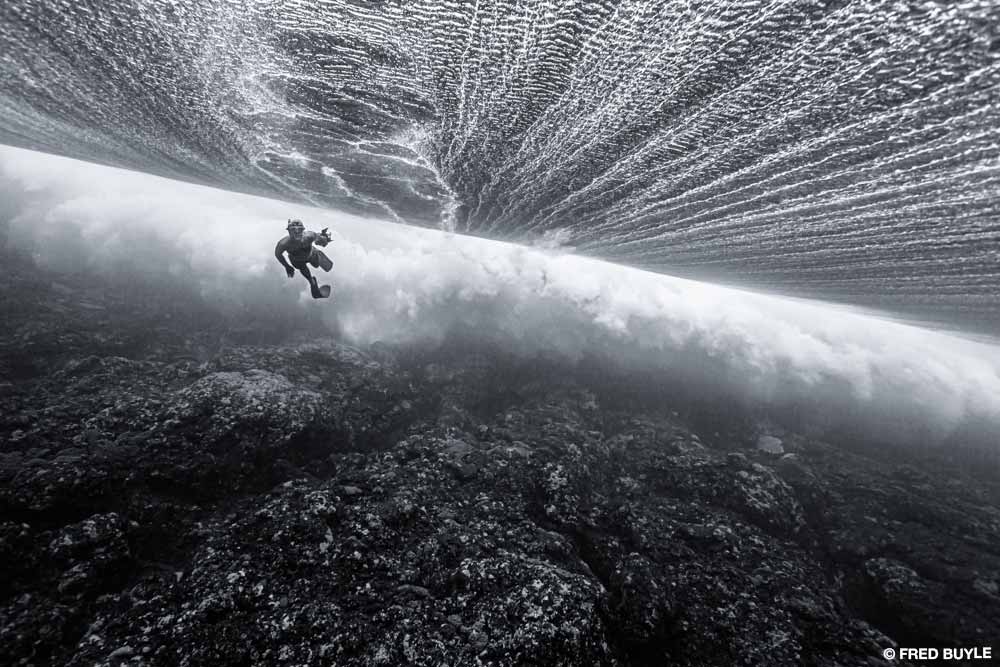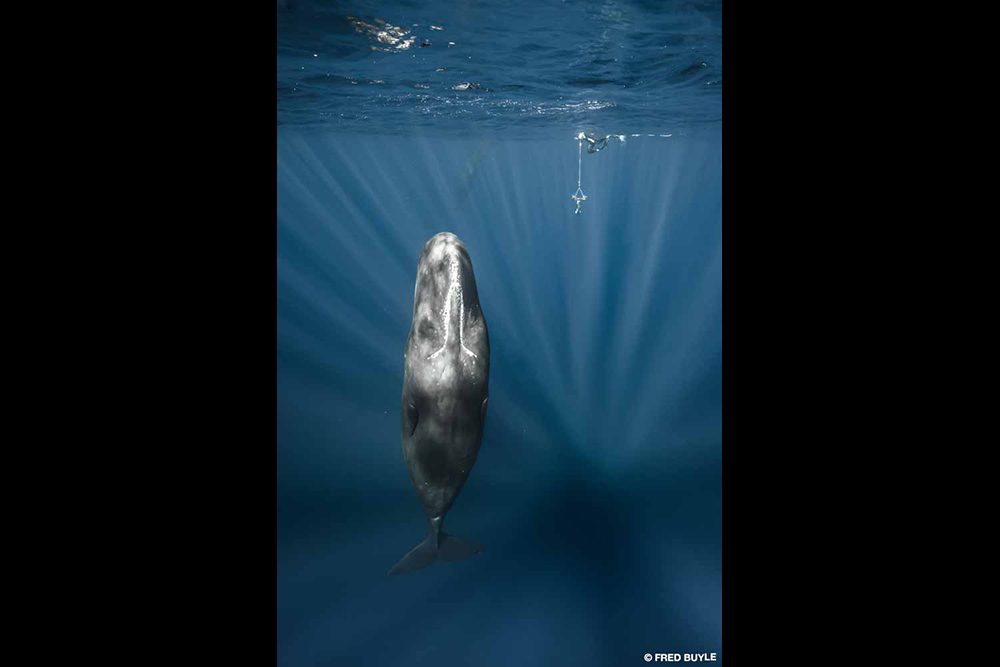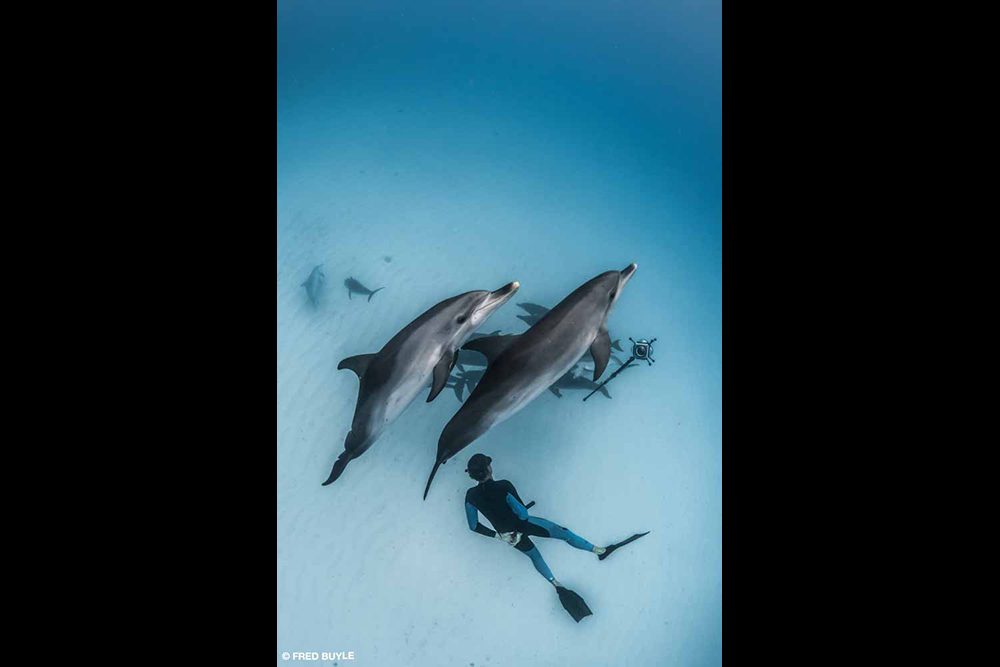A breath of air — nothing more, nothing less
A STATEMENT ON FRED BUYLE’S WEBSITE briefly explains his approach to underwater photography: “To take his pictures and videos, Fred uses a simple formula: the water, available light, a camera, and one breath of air, nothing more, nothing less.” I would add to that list an extraordinary eye for composition and a passion for placing himself wherever the photo opportunities are. The images in his portfolio represent decades of travel to exotic destinations far from his home in the Azores. He has tolerated fewer overweight baggage fees than other photographers might, for his life and aesthetic are remarkably minimalistic for a man of such accomplishment.

Buyle came to photography naturally — some might say genetically. His great-grandfather was an innovative and acclaimed photographer in Brussels and portraitist to the Belgian royal family. His grandfather was a fine art painter, and his father was an advertising and fashion photographer in the 1960s. Buyle missed the active era of his father’s life in fashion photography, as he was retired from that career by the time Buyle was born.
For at least two months each summer the family sailed to Denmark, the United Kingdom, and Norway. Boating was a family passion, and while his parents weren’t divers, Buyle was curious about all things related to the ocean. He began reading voraciously at 4 years old. By the age of 7 he was satisfying his curiosity about the underwater world by snorkeling, and he started spearfishing a few years later. As he had to go deeper for game, he learned to equalize. He spent more time observing than spearing fish, and freediving became a part of his life.
Adolescent, il a obtenu son brevet de plongée en Belgique et est devenu divemaster PADI à 18 ans, puis instructeur un an plus tard. Cependant, le fait de dépendre d'une bouteille et d'un détendeur ne l'a jamais autant intéressé que l'esthétique de la respiration unique. L'apnée est devenue un sport plus organisé dans les années 1990, et Buyle en a fait partie. En 1995, il établit son premier record du monde avec 167,3 pieds (51 mètres) dans la catégorie des poids variables, suivi en 1997 par le record des poids constants avec 173,9 pieds (53 mètres). Il a battu ce record plus tard, en 1997, avec 190,3 pieds (58 mètres) et en 2001 avec 213,3 pieds (65 mètres). En 1999, il a franchi la barrière la plus difficile de l'apnée, à savoir 100 mètres, devenant ainsi la huitième personne à le faire.
En 2000, vous étiez clairement considéré comme un roi de l'apnée, mais quand avez-vous commencé à faire de la photographie sous-marine ?
By 2002 I had grown bored with freediving for records, but I wanted memories of what I saw underwater. About that time magazines became interested in freediving competitions, so photographing freedivers was a natural transition for me. The elite freedivers were a small community, and we had mutual trust. I had the skills to get deep enough to take a dramatic photo, yet I knew enough about the culture to stay out of the way and not interfere with the dive. You can’t ask your model for one more take during an international competition, so I learned to get it right the first time.
I took my first digital underwater photos in 2001, so if you began shooting in 2002, I’m guessing you never shot film.
That’s true. I began my underwater photography using a Nikon Coolpix digital camera. The digital files weren’t too bad, but the shutter lag was horrible. You had to press the shutter release and anticipate where your subject would be when the camera took the shot. I moved to Canon digital cameras for better-quality files, more lens options, and an improved shutter. Cameras continued to improve among all manufacturers, and by 2016 I had switched back to Nikon and eventually became one of their ambassadors. I had been shooting a Nikon D810 but have upgraded to a Nikon Z 7II in an effort to have a smaller and more streamlined in-water footprint.

Vous semblez maintenant vous intéresser aux grands animaux, souvent avec des apnéistes, mais en mettant l'accent sur la mégafaune marine charismatique.
I’ve always loved being with big animals, but freediving is very much a team sport. We all know the risks of shallow-water blackout, so we travel and dive together. It is important to be a good safety role model, and even today I might drop down to 200 feet for a photo opportunity, so we rely on the security that comes from watching each other’s backs. Our safety protocols are always in place, even if it is a relatively shallow dive to photograph sleeping sperm whales. Since two or more of us are always in the water, I can place a freediver near the marine life. It provides scale and human interest, and my buddies want to be next to big critters anyway. I have the benefit of being there to get the shot.
The diversity of your subject matter — great whites, tiger sharks, mantas, whale sharks, sperm whales, and even belugas — gives a sense of how geographically committed you are. Since you can travel lightly without strobes and scuba gear, do you feel that contributes to a minimalistic approach?
That is how I travel and how I live. I am very minimalistic. I live in the Azores so I can be near the sea. When conditions are right, I can grab my camera, quickly jump on a boat, and find myself in the water with blue sharks, mobula rays, or whatever else is out there. You never know what kind of encounter you might have, and interacting with it all is the great joy of my life. But my travel isn’t random. I have an idea of what to shoot and where to go to succeed.
En 2007, par exemple, je voulais prendre des photos de grands requins blancs en eau claire. Mark Addison a eu la chance de plonger en apnée avec des requins dans l'océan Indien, au large de la côte est de l'Afrique du Sud. Il avait découvert que si l'on attendait que l'eau chaude et claire arrive par les pinacles, on pouvait rencontrer des grands requins blancs. Nager sans cage était rare à l'époque, mais Mark l'avait souvent fait et m'a fait comprendre que c'était possible. Cette expérience magique m'a permis de mieux comprendre le comportement des requins. Cette année-là, mes photos d'apnéistes nageant paisiblement aux côtés d'énormes requins tigres en Afrique du Sud ont été largement diffusées et sont devenues mes premières images virales.
A lot of my other work in conservation circles happened because freedivers can do things that are impossible on scuba or rebreathers because they are too cumbersome and intimidating to the animals. We attached acoustic tags for tracking migration to scalloped hammerhead sharks in Rangiroa, Tahiti, along the Eastern Pacific Corridor (the Galápagos, Cocos, and Malpelo), and to great whites off Guadalupe Island in Mexico. Our unobtrusive presence made us valuable underwater assistants to the shark researchers.
Votre appareil photo principal est le Nikon Z 7II sans miroir, qui est moins résistant à l'eau. Trouvez-vous cette caractéristique importante ?
My equipment evolution is always for size and efficiency. When I travel I have one checked bag with my clothes, fins, mask, snorkel, and wetsuit. My carry-on backpack contains one camera and housing, a spare camera body, and two or three lenses. I don’t need strobes or macro lenses. For me, it is all wide-angle, available light, and one breath of air.
En parlant d'une seule respiration, devez-vous vous entraîner en permanence pour rester au top de votre efficacité en apnée ?
I haven’t trained for freediving since 2004, when I quit competing. It is about having a healthy lifestyle. I swim quite often, ride my bike, and pay attention to what I eat. Stretching helps me quite a bit, and I have a rowing machine for when the weather is bad. Honestly, I’d rather work in my garden or take a nice walk every day. I’m fortunate that I can still accomplish the work I want to do, and I look forward to the next grand adventure!
See more of Buyle’s work at nektos.net.
En savoir plus
See more of Fred Buyle’s work in a bonus photo gallery and in the videos below.
